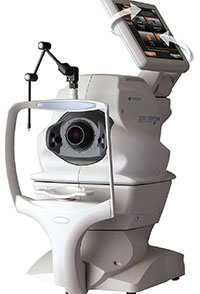 |
Topcon also highlights the mobility of the device. At 46.3 pounds, and with the new rotating touchscreen control panel, the size of the new OCT doesn’t dictate its location. Some of the new features of the OCT include cataract mode, interactive reports, auto-centering of the fovea and optic disc and fundus image utilities that include auto-mosaic and patient education functions.
For more information, visit topconmedical.com.
Volk Optical Adds Gonio Lenses
Volk has introduced single-use gonio lenses to provide maximum convenience and safety to patients, without compromising image quality for visualization, diagnosis and laser treatment, the company says. Volk specifically uses single-use three- and four-mirror gonio lenses, which provide high image resolution of the anterior chamber angle, peripheral retina and posterior pole, similar to the images captured with Volk’s glass gonio lenses.
Both the three- and four-mirror lenses have an image magnification of 1x and 1x laser spot. The three-mirror gonio lens has mirrors angled at 60, 66 and 76 degrees, eliminating gaps in the visualized fundus. The four-mirror gonio lens’s mirrors are equally angled at 63 degrees for visualization of the entire anterior chamber.
Volk claims that the new single-use lenses eliminate the potential for cross-contamination of infectious disease, as well as the costly reprocessing of reusable lenses.
For more information, visit volk.com.
LENSTAR Gets Hill-RBF Calculator
Haag-Streit’s newly introduced Hill-Radial Basis Function calculator, included in the next EyeSuite software cycle available to LENSTAR users, provides a new system for intraocular lens power selection.
The Hill-RBF uses pattern recognition and data interpolation to determine IOL power. Haag-Streit believes that the advantage of pattern recognition for selecting an IOL power is its use of adaptive learning. In this system, short, normal and long eyes are viewed as patterns. The Hill-RBF IOL power selection system also uses the boundary model, which indicates to the user when the calculator is performing within a defined area of accuracy.
Haag-Streit notes that unlike older, static theoretical formulas, this approach will be updated on a regular basis.
For more information, visit rbfcalculator.com.
Bausch + Lomb Launches EZ-24
Bausch + Lomb says its new EZ-24 Easy-Load lens delivery system provides smooth and easy delivery of the SofPort IOL through a 2.4-mm incision, resulting in a simple procedure and minimal post-procedural irritation.
B+L adds that the new delivery system features a smooth oval tip designed for ease of wound entry, reliability and control. The company claims that by combining the benefits of sterile, single-use, “no-touch” lens-loading design with planar delivery, the injector allows direct placement of the IOL into the capsular bag, minimizing tissue trauma and other potential complications. Additionally, B+L notes that the M-folded delivery allows the physician improved control of lens delivery.
For more information, visit bausch.com.
Zeiss Digital Refraction Tech Integrates with Leading ERM Software Systems
Zeiss recently announced the wireless integration of its Essential Line of digital refraction instruments with popular electronic medical record software systems such as Compulink, Crystal, OfficeMate, ExamWriter, My Vision Express, OD Link, Practice Director and Revolution EHR.
Now Zeiss customers can send data wirelessly from EL instruments to the now compatible EMR software. This allows data from the Zeiss instruments to be loaded into the EMR software as the patient undergoes the exam process, ensuring that relevant data is immediately accessible to the doctor.
The Zeiss EL instruments that work with the EMRs include: Visulens 500 Auto Lensmeter; i.Profiler plus Aberrometer/Topographer; Visuref 100 Autorefractor/Keratometer; Visuscreen 100/500 Acuity Systems and Visuphor 500 Digital Phoropter.
For more information on Zeiss’s integration with EMR, visit zeiss.com/vision-care/en_us/products/dispensing-tools-and-instruments-by-zeiss.htm
Eyefficient’s New MediWorks Equipment
Eyefficient recently partnered with MediWorks to introduce its new line of ophthalmic equipment, including new digital slit lamp imaging and LED vision chart systems.
With the new product line, Eyefficient is also partnering with a national engineering firm to provide nationwide installation and service to their new equipment. Because of this partnership, Eyefficient boasts the ability to provide warranty service anywhere in the Unites States within 24 hours. The Eyefficient catalog includes brands from MediWorks, S4OPTIK, Volk, Accutome and Yeasn.
For more information on Eyefficient’s new products and partnership, visit eyefficient.com. REVIEW



